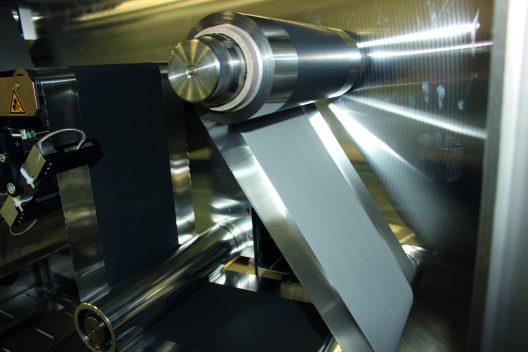Imagine a battery that reduces the overall number of structural parts in an electrical vehicle and the volume taken up by the battery. That’s the concept behind EMBATT (chassis embedded battery), which functions as structural energy storage. It can cut the volume occupied by a battery in half, with serendipitous outcomes for lightness and structural efficiency. This is similar to NASA-backed research on cubesat walls that also function as energy storage structures.

Fraunhofer, Krupp, IAV laminated battery increases volumetric efficiency for energy storage
IAV is a German firm that provides consultation and partnerships with leading automotive companies. It specializes in synergistic concepts and system-level thinking. The company, working with Fraunhofer Institute for Ceramic Technologies and Systems IKTS in Dresden, and Thyssen Krupp System Engineering ,“Want[s] to use our experience from automotive development for renewable energies and decentralized energy supply.” It sees strong links between these endeavors, and works to combine technologies that will enable greater efficiency.

Cylindrical cells, no matter how highly packed, leave a lot of room not storing energy
Think of a Tesla battery pack, composed of individual cells connected in series and parallel to get the desired Voltage and Amperage necessary to make the wheels turn. Because the large, underfloor pack uses cylindrical cells (originally 18650’s – 18 millimeters in diameter and 65 millimeters long), there is space around the contiguous cells. EMBATT makes the battery layers that would normally be wound up “Tootsie Roll” style in a cylinder, flattens them out and makes them the actual floor of the vehicle.
IAV explains the consequences of that approach. “Today’s lithium batteries… consist of a wound or stacked structure that is inserted into cylindrical or prismatic cell housings or sealed in a pouch. The energy density falls to 40 to 60 percent of the value at cell level merely by packaging cells individually and additionally installing the cells in the system. As a result, today’s battery systems only reach between 140 and 300 Wh/l (Watt-hours per liter).”

Comparison of EMBATT characteristics with other cells. The dark blue is Energy density per cell; light blue represents the share of active material per cell volume; Dark orange. Energy density per system; and light orange, Share of cell volumes per system
Fraunhofer explains that, “…Electric cars are equipped with hundreds to thousands of separate battery cells. Each one is surrounded by a housing, connected to the car via terminals and cables, and monitored by sensors. The housing and contacting take up more than 50 percent of the space. Therefore, the cells cannot be densely packed together as preferred. The complex design steals space. A further problem: Electrical resistances, which reduce the power, are generated at the connections of the small-scale cells.
EMBATT is a planar battery, and it essentially becomes the floor of the vehicle. IAV battery system developer Michael Clauss says that such a setup of bipolar electrodes with a surface area of two square meters (21.5 square feet) “make it possible to to break up the conventional cell and module boundaries and integrate the energy storage system as a component into the vehicle chassis.” Integrating the batteries into the vehicle’s underfloor “can double the share of active storage material up to 80 percent of battery volume.”
Up 850 Volts can be delivered currently (no pun intended), and up to 1,200 Volts in the future, enabling ranges up to 1,000 kilometers (620 miles).
The EMBATT bipolar battery consists of cells which are stacked in a stack-type manner such that the arrester of the negative electrode of a cell represents the contacting of the positive electrode of the next cell. Thus, two electrochemical cells are connected in series – the one side of the bipolar electrode serves as an anode in one cell and the other as a cathode in the next cell. The larger and thicker the electrodes are, the higher the capacity of the battery.

Production of the bipolar electrode on a pilot scale.
Most important in this battery, the bipolar electrode – a metallic tape that is coated on both sides with ceramic storage material – has two large, flat sides. One side becomes the anode, the other the cathode. Dr. Mareike Wolter, Project Manager at Fraunhofer IKTS, explains, “We use our expertise in ceramic technologies to design the electrodes in such a way that they need as little space as possible, save a lot of energy, are easy to manufacture and have a long life. One of the core competencies of our institute is to adapt ceramic materials from the laboratory to a pilot scale and to reproduce them reliably.“ The partners hope to be able to demonstrate full-scale batteries in cars by 2020.
Certainly the ability to reduce battery size while retaining gravimetric energy density is a desirable goal. Even more desirable is a smaller, lighter battery with greater energy storage capabilities.

